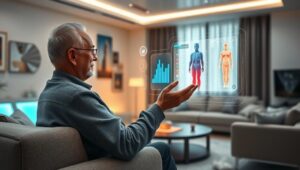The Internet of Medical Things (IoMT) is poised to revolutionize elderly care and independent living by 2026. This article explores the advancements, applications, and implications of IoMT in enhancing the quality of life for seniors.
Advancements in IoMT Technology
By 2026, IoMT devices will be more sophisticated, user-friendly, and integrated into daily life. Key advancements include:
- Miniaturization and Wearability: Smaller, more comfortable wearable sensors will continuously monitor vital signs, activity levels, and sleep patterns.
- AI-Powered Analytics: Advanced algorithms will analyze data in real-time, providing personalized insights and early warnings of potential health issues.
- Seamless Connectivity: 5G and improved Wi-Fi infrastructure will ensure reliable data transmission and remote monitoring capabilities.
- Improved Battery Life: Extended battery life will reduce the need for frequent charging, increasing user convenience.
Applications of IoMT in Elderly Care
IoMT devices and systems will support elderly individuals in various aspects of their lives:
- Remote Health Monitoring: Continuous monitoring of vital signs, medication adherence, and chronic conditions, enabling timely intervention by healthcare providers.
- Fall Detection and Prevention: Wearable sensors and smart home systems that detect falls and automatically alert emergency services.
- Medication Management: Smart pill dispensers and reminder systems to ensure accurate and timely medication intake.
- Activity Tracking and Encouragement: Monitoring daily activity levels and providing personalized recommendations to promote physical activity and social engagement.
- Smart Home Integration: Voice-activated assistants, smart lighting, and automated appliances to enhance comfort and safety within the home environment.
Implications for Independent Living
IoMT will empower seniors to maintain their independence and age in place:
- Enhanced Safety: Reduced risk of accidents and emergencies through proactive monitoring and alerts.
- Improved Health Outcomes: Early detection and management of health issues, leading to better overall health and well-being.
- Increased Social Engagement: Connectivity with family, friends, and caregivers through communication devices and social platforms.
- Reduced Healthcare Costs: Preventative care and remote monitoring can reduce the need for hospitalizations and costly interventions.
Challenges and Considerations
While IoMT offers numerous benefits, there are challenges to address:
- Data Privacy and Security: Robust security measures are essential to protect sensitive health information from cyber threats.
- User Adoption: Training and support are needed to ensure elderly individuals can effectively use and benefit from IoMT devices.
- Interoperability: Standardized protocols are needed to ensure seamless integration of IoMT devices and systems.
- Regulatory Frameworks: Clear guidelines and regulations are needed to address ethical and legal issues related to IoMT data and applications.
By 2026, IoMT will transform elderly care and independent living, offering innovative solutions to enhance the quality of life for seniors. Addressing the challenges and considerations will be crucial to realizing the full potential of IoMT in this domain.




